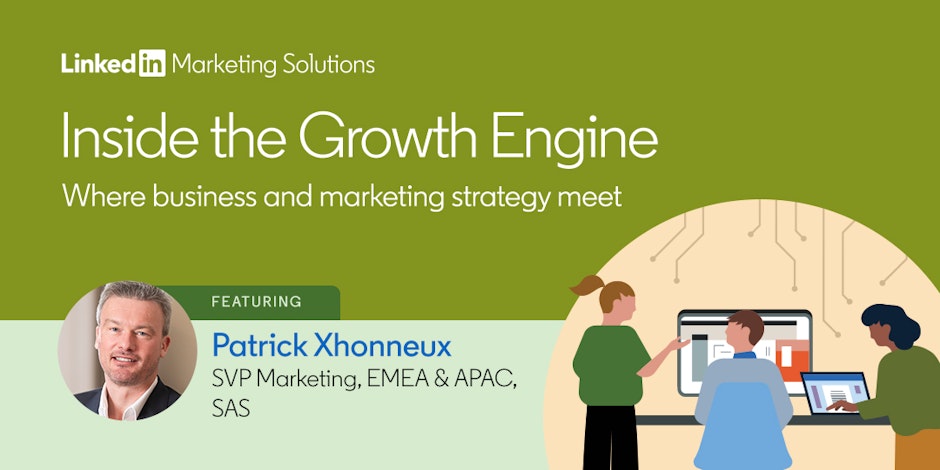Patrick Xhonneux on marketing uncertainties, brand marketing and the value of curiosity
Patrick Xhonneux (SVP marketing EMEA & APAC for SAS) believes that the best drivers of innovation and transformation are marketing leaders who know their limits – and empower others to take the initiative

The field of physics known as quantum mechanics could be said to come down to knowing what you can’t know – but doing your best to quantify it anyway. It turns uncertainty about how subatomic particles really behave into probabilities about what they’re likely to do – and predictions and experiments that hold true with a high degree of accuracy. For Patrick Xhonneux, SVP Marketing EMEA & APAC at the business analytics software provider SAS, it’s fuelled a lifelong fascination with a pretty intimidating branch of science. It’s also provided a valuable way of thinking about the impact of marketing.
“I’d love to say it’s easy to calculate something like customer value with a mathematical formula – but just as with quantum physics, you have a lot of uncertainties,” he says. “At SAS, we’ve become pretty good at computing the quantitative elements, but part of that is agreeing on how you’re going to weight the formula to take account of the intangibles as well.”
Xhonneux has identified perceived customer value as one of the crucial ways that marketing contributes to growth. Some, such as demand generation marketing and its contribution to pipeline, are relatively easy to quantify. Others, like brand marketing, have to be differentiated and explained to stakeholders as manifesting themselves in different ways. And some, such as the customer value on which revenues and growth for a software provider depend, are shaped and influenced by marketing but can’t be entirely controlled.
Building brands around a clear view of customer value
“The engagement whereby marketing creates and reinforces customer value is so important in today’s world,” he says. “However, that value is influenced by all of the divisions of the company, not just sales, marketing or customer success. You can have the best product, price and sales team, but if your financial processes or shipments are too slow, you are undermining that value.”
It’s perhaps not surprising that a marketer whose career has included roles as director of strategy and director of government affairs should take a broad, business-wide view of what it takes to build a compelling SAS brand. “The role of brand marketing has become more important with digital buyer journeys, but so have aspects like social selling, influencer advocacy, organic communication and search engine optimization,” he says. “You don’t change perceptions in the market overnight, and it’s not enough to build awareness. You want to make sure that people can find you, that they can recognise you, that they’re very clear about the particular value you represent and that they can relate to it.”
For Xhonneux, maintaining that clear sense of value throughout increasingly rapid, increasingly digital buyer journeys has to be a driver of continuous transformation for marketing and the wider business.
Designing a marketing department for business transformation
“Whether we’re consumers or B2B customers, we want things faster and we want them more personalized,” he says. “The technology and skills required to engage with customers are rapidly changing. In today’s world, excellent organizations don’t believe in excellence. They only believe in constant improvement and constant change. It’s about managing change for senior leaders and keeping modernization going. On a higher level that means: keeping curiosity within the organization high as it is a key driver for innovation. Being (or staying) curious greatly helps to deal with ever and rapidly changing customer needs and preferences.” This is not a mere assumption, but has recently been shown by the Curiosity@Work report from SAS.
If marketing is to play this kind of role as a transformation driver, then marketing departments need to be designed with innovation in mind – and led in a way that identifies and responds to new ideas. Xhonneux has developed a shared service and network organization for his EMEA marketing team, that does away with traditional hierarchical structures, embeds marketers alongside sales in different markets, empowers their creativity, and then swiftly scales the best ideas to avoid duplication of effort.
“I’m very proud of the organization that we’ve created,” he says. “It means that people can specialize in different areas of marketing wherever they are in the world. It makes sure that we use the creativity and innovation that comes from people in the field to accelerate transformation while empowering future leaders and better serving our customers. I see it as a real source of competitive advantage, and something that will help us retain and develop talent, particularly among Millennials and Gen Z.”
It’s also a structure that works best when it’s led by someone who’s comfortable with the limits of what they know. “The idea that leaders are supposed to know everything is foolish today because everything is evolving so fast,” says Xhonneux. “You need to trust and support the creativity, the intelligence and the connection with customers at every level to accelerate the pace of innovation within the company.”
As a transformative marketing leader, you may not know exactly where the next valuable idea will appear. Like a good quantum physicist though, you can predict with confidence that it’s on its way.

